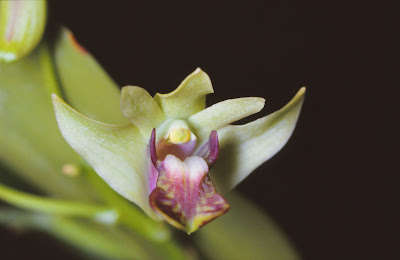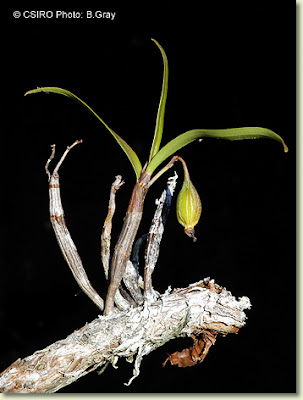Dendrobium fellowsii is found in northeastern Queensland. It grows on shrubs and trees in open forests at elevations of 450 to 1000 meters above sea level.
Dendrobium fellowsii also called as Fellows' Dendrobium, Callista bairdiana, Dendrobium bairdianum, Dendrobium giddinsii, Eleutheroglossum fellowsii, Sayeria bairdiana, is a species of the genus Dendrobium. This species was described by Ferdinand von Mueller in 1870.
IDENTIFY DENDROBIUM FELLOWSII ORCHID PLANT
Dendrobium fellowsii is found in northeastern Queensland. It grows on shrubs and trees in open forests at elevations of 450 to 1000 meters above sea level.
It is a miniature sized, cool to warm growing epiphyte with tufted, slender, constricted at the nodes, dark purple brown, ribbed, 3-7 inches high, about 1/2 inch thick, pseudobulbs carrying 2 to 5, linear-lanceolate, marginally curved, about 2 inches long by 1/2 inch wide leaves that are held towards the apex of young growths.
Fellows' Dendrobium blooms in the spring and early summer on a 2 to 8 cm long, 2 to 7 flowered inflorescence arising from both mature leafless and leafed pseudobulbs. The flowers are small with yellowish green sepals and petals. The labellum is shorter than the petals and is paler in colour, the side lobes being veined with deep purple.
DENDROBIUM FELLOWSII ORCHID PLANT CARE AND CULTURE
Cultural information should only be used as a guide, and should be to be adapted to suit you. Your physical location; where you grow your plants, how much time you have to devote to their care, and many other factors, will need to be taken into account. Only then can you decide on the cultural methods that best suit you and your plants.
Light:
Dendrobium fellowsii do best in full sunshine (25000-50000 lux), close to the glass where glasshouse treatment is required. In addition to the natural light, you will have to use artificial light lamps.
Temperature:
The average temperature of the summer day is 25-26 ° C, night 21 ° C, giving a daily difference of 4-6 ° C. In winter, the average day temperature is 27-30 ° C, night 16-17 ° C, giving a daily difference of 13 ° C.
Humidity:
Fellows' Dendrobium need the humidity of 80-90% throughout the growing period (i.e. from the time the first shoots of Spring show themselves until the last pseudobulb in Summer has grown to its maximum). Too dry air has a negative effect on the development of the plant: its growth is inhibited, and the leaves begin to turn yellow and dry out. The higher temperature, the higher the humidity should be, and the higher the humidity, the more often and longer it is necessary to ventilate the room where the plants are contained, otherwise the probability of rotting and various kinds of fungal diseases.
Substrate, growing media and repotting:
Dendrobium fellowsii grows best in pots with staghorn peat as substrate (crocks and charcoal at the bottom ot the pot). After potting, keep the plant in a cool, shady place for a few days before placing it in its growing position. Do not overpot. Use the smallest pot that will accommodate your plant.
It does not need frequent repot, therefore, it is desirable to transplant only when it is really necessary, for example, in cases of strong salinization or compaction of the substrate, at its critically high or low pH (the norm is from 5.5 to 6.5) or when the plant grows very strongly and the pot becomes cramped to it (pseudobulbs begin to hang from the edges of the pot). Repotting is best done immediately after flowering when new roots and new growth begin to grow.
Watering:
Fellows' Dendrobium water must be literally poured on throughout the summer season right up to the time when the season's growths have reached full development; with the coming of autumn the quantity of water should be appreciably diminished, but this plant should not be allowed to dry out, and even in midwinter watering should be continued by giving the compost a good soaking once a fortnight-choosing a bright, clear morning for the purpose.
Watering is directly dependent on the temperature of the content, the higher it is, the more often it needs to be watered. When watering, excess water should flow freely from the pot, since stagnation of water both inside the pot and in its pan can very quickly lead to rotting of the roots and the lower part of the plant.
Fertilizer:
It is recommended to use a 1/4-1/2 dose of orchid fertilizer weekly. You can use the balanced fertilizer throughout the year or from spring to mid-summer use high-nitrogen fertilizer, and then until the end of autumn high-phosphoric fertilizer to stimulate flowering.
Rest period:
Dendrobium fellowsii need less water in the winter, especially if they grow under the conditions of a dark, short day that occurs at moderate latitudes. They should dry somewhat between waterings, but they should not be dry for a longer period. Frequent morning fogging and rare, economical watering should allow the plant to go through a dry period of rest, while providing it with sufficient humidity. Fertilization should be reduced or eliminated until new growths appear and a more abundant spring watering begins.















COMMENTS